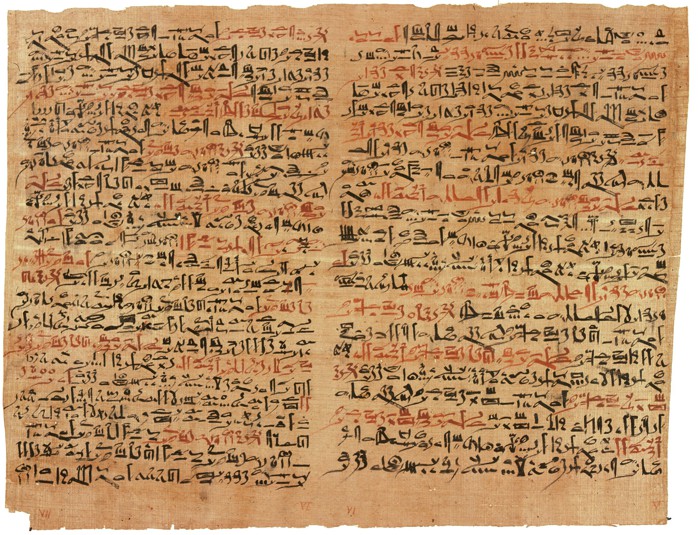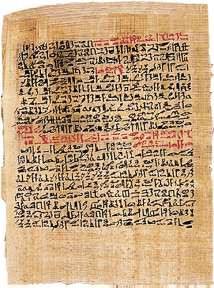
Excerpts taken from Magic and Medical Science in Ancient Egypt, by Paul Ghalioungui (1963)
Although most of the medical papyri we know come from about the Renaissance, it is certain that they are only copies, often third- or fourth-hand ones, of older works. Occasionally stray pages were copied on the papyrus scrolls by scribes with no previous medical training, who paid no attention to continuity of subject.
Long ago, when writing was a secret science, the Egyptian scribe was not a simple copyist. He had the combined training of a calligrapher, a philosopher, a scholar and a scientist. Many physicians prided themselves on bearing the title of scribe among their others, and like Hesyreh, had themselves portrayed with the palette and reeds, the sesh, symbol of that learned class. The actual copying was probably performed in the pir-ankh or Houses of Life that were attached to the temples and where the scholars, physicians, philosophers and scientists of the time used to meet.
We know of nine principal medical papyri. They are called after their original owners (Edwin Smith, Chester Beatty, Carlsberg), the site of their discovery (Kahoun, Ramesseum), the towns were they are kept (Leyden, London, Berlin) or their editor (Ebers).
The Kahoun Papyrus is the most ancient scroll and was discovered at Fayoum and was called by mistake the Kahoun Papyrus. It dates from 1950 B.C. And has on its back an account from the time of Amenemhat III (1840-1792 B.C.). Not only is this the oldest known papyrus, but the original from which it was copied seems also more antique than the originals of the other papyri.
It consists of three sections, one dealing with human medicine, the second with veterinary science, and the third with mathematics. It is written in hieratic handwriting like the other papyri, except the veterinary section which, possibly because of its greater antiquity, is written in hieroglyphic, a script usually reserved for theological writings.
The medical section is composed of three leaves; the first, found in a very fragmentary condition, was already repaired in ancient times with strips from other papyri pasted on the back.
The first two pages contain 17 gynecological prescriptions and instructions without titles. No surgery is prescribed; substances recommended are beer, milk, oil, dates, herbs, incense and sometimes repulsive substances. Use is often made of fumigations, pastes, and vaginal applications.
The third page contains 17 prescriptions concerning the assessment of sterility and of pregnancy, and the ascertaining of the sex of unborn children. Many of the indications concerning pregnancy and childbirth refer to the state of the breasts, their firmness and to the color of the face and eyes.
The Ramesseum IV and V papyri were probably written about 1900 B.C., i.e. At about the same epoch as the Kahoun Papyrus.
Papyrus IV is very similar to the Kahoun Papyrus; it contains many identical prescriptions and also is concerned with labor, the protection of the newborn on the day of its birth, the prognostication of its viability, and it contains one anti-conceptional formula made out of crocodile dung which completes a similar one in the Kahoun papyrus.
Papyrus V is purely medical. Even though its beginning and end are lost it still contains 20 prescriptions of which many are dealing with relaxing ‘stiffened’ limbs. This papyrus is written in hieroglyphic script, and not in hieratic. The titles are written in horizontal lines at the top of the pages and the prescriptions are listed underneath in vertical columns.
The Berlin Papyrus was found at the time of Usaphais in an old chest containing antique writings. The legend states that it was found in a chest with scribe’s tools, under the feet of a statue of Anubis at Letopolis under Usaphais, the 3rd Pharaoh of the 1st dynasty. It covers 25 pages and contains 240 recipes, of which three are written in a different handwriting. A large part of its contents consists of a word-for-word repetition with many errors and careless copying of certain paragraphs of the Ebers and Hearst documents. Included are sections on rheumatism, a treatise on vessels similar to the second book on the heart, in the Ebers papyrus, a gloss that completes the latter, and a note on its origin, more detailed than that which is found in Ebers.
The London Medical Papyrus lies midway between a medical papyri and a non-medical work of pure magic. It contains 61 recipes of which only 25 are medical. The rest, of which part is of foreign origin, is purely magical. It claims to be discovered by the priests of the temple of Tebmut in the sanctuary of the goddess: “Behold! The darkness of the night enveloped the Earth but the moon cast her beams upon all pages of this book and it was brought to the treasury of His Majesty King Khufu.”
The Hearst Papyrus covers 18 and a half pages and describes 260 medical cases of which 96 are found in the Ebers Papyrus. It contains also a chapter on bone affections. On the whole, it is considered inferior to the Ebers papyrus, although it improves on it in certain passages.
The Ebers Papyrus is the longest of all the known papyri and the most important, considering the physiological and medical knowledge it reveals. It is complete in 108 pages and bears the date of the 9th year of the reign of Amenophis I (1550 B.C.).

The Ebers does not constitute a book in our modern sense. It is rather a mosaic of leaves and extracts drawn from different sources and compiled at the scribe’s will.
It starts with a magic introduction, possibly aiming at reassuring its user as to its divine origin and at asserting that the power of magic derives from Thot the benefactor, charged by Re to relieve suffering humanity: “I have come from Heliopolis with the old ones in the temple, the possessors of protection, the rulers of eternity; I have come from Sais with the mother of the gods. They have given me their protection. I have formulae composed by the lord of the universe in order to expel afflictions caused by a god or goddess, by dead man or woman, etc., which are in this my head, in this my nape, in these my shoulders, in this my flesh, in these my limbs, and in order to punish the Accuser, the head of them who cause decay to enter into this my flesh, and feebleness into these my limbs. I belong to Re; he has said: ‘I will save him from his enemies and Thot shall be his guide, he who lets writing speak and has composed the books; he gives to the skillful, to the physicians who accompany him, skill to cure. The one whom the god loves, him he shall keep alive.'” The last sentence could be used as a spell for the patient had to say, ‘It is I whom the god loves and he shall keep me alive.’
In parts of the papyrus we find theological tendencies and attributions of many of the prescriptions to the gods.
Other sections contains information on digestive diseases and worms and their treatment, sections on the treatment of eye diseases, on the care of the skin and hair, on fractures and burns, resembling very much the Edwin Smith papyrus; on the treatment of stiffened and painful limbs, on gynecological disease which often repeats in the Kahoun papyrus, a treatise on the heart and vessels which is the only one dealing with anatomy and physiology, and finally a surgical section limited to tumors and abscesses.
Whereas the previous papyri are mainly collections of prescriptions, the 877 paragraphs of this compilation contain, besides the therapeutic recipes, diagnostic notes and, for the first time in history, theoretical considerations on the problems of life, health, and disease devoid of religious or magical considerations. Some of the illness identified include anasacra, leprosy, fevers, dysentery, different kinds of worms, heart disease, dropsy, faintness, rheumatism, stiffness of joints and limbs, liver diseases, polyuria (possibly diabetes), intestinal obstructions, gangrene, burns, blisters, affection of the ears, nose, tongue, gums and teeth, sections on how to stimulate hair growth, diseases of the breast, gynecological diseases, contraceptive measures, and methods to help childbirth and gonorrhea.
The descriptions are pretty, often poetic. A weak person is compared to a “breath that passes away.” Many are remarkable in their precision such as those of angina pectoris, aneurysm and hernia.
In our last issue we gave a basic overview of the various papyri. Our present article will discuss practical applications of the ancient Egyptian medicine. The following information is quoted from Magic and Medical Science in Ancient Egypt (see end of article for full information).
“The physician was taught to deal gently and meticulously with his patients. Reading the papyri one is constantly struck by the kindness shown to the maimed and the diseased. Whatever their illness, the sick were never considered, as in some other civilizations, untouchable, demon-possessed creatures. The wise Amenemope says, ‘Do not mock at the blind; do not scoff at dwarfs; do not injure the lame; do not sneer at a man who is in the hand of God (of unsound mind).’ A suffering person is not to be left without help: Go in to him, and do not abandon him.” (Ebers 200)
During clinical consultations there was a detailed examination in the course of which the physician had to exert his powers of observation to the utmost to detect as many symptoms and to elicit as many signs as he could. According to the available clinical descriptions, it started with a detailed history-taking and questionnaire.
A detailed inspection of the face: color secretions from nose, eyes, of the neck abdomen, and limbs: swelling, shaking, varicosities, perspiration, stiffness. The general appearance and nutrition of the body were observed: ‘…[a patient] whose body shrinks’ (Ebers.197); the expression of the face: ‘If …thou findest that he has been changed and has turned deathly pale [this one has crossed the channel to the beyond]’ (Eb. 198); the color of the eyes; the pigmentation and the color of the skin: ‘…If thou findest on his shoulders, his arms that there is color…’ We find statements such as there is a ‘perishing of the mind’ and ‘his heart is forgetful like one who is thinking of something else.’
The smell of the body, of the sweat, of the breath and of wounds was noted. A wound in the Smith papyrus is said to smell like the urine of sheep; the breath of a patent is compared to a latrine; the smell of a mother’s milk is said to be like a particular fruit and like that of fish if bad; and a gynecological lesion smells of burnt meat.
Urine and fecal matter were then inspected: ‘thou shalt rise every day to examine that which has fallen from his hinder part… if… comes out of him like black bile, then… if thou examinest him after doing [treatment] and something comes out of his anus like porridge of beans, then thou shalt say to this: that which is in his cardia has come out.’
So we can see that great care was taken to listen to how the body was functioning.
Palpation of the pulse was very important and noted in the papyri. Also that of the abdomen was no less important: ‘If thou examinest a man suffering from a resistance in his cardia, and thou findest that it goes and comes under thy fingers like oil in a leather bag…’, or ‘…then thou shalt examine him lying extended on his back. If thou findest his belly warm and a resistance in his cardia, thou shalt say to him: it is a liver case. Thou shalt prepare the secret herbal remedy which is made by the physician… If, after having done that, thou findest the two sides of the belly: the right one warm, and the left one cool, then… thou shalt again examine him, if thou findest his entire belly cool thou shalt say: his liver is opened he has received the remedy [i.e. the remedy has operated].
The palpation of tumors was detailed and painstaking. The temperature of different parts of the body was compared. Wounds were also felt with the same care: a fractured skull was compared to a punctured earthen jar, the pulsations of the brain were compared to those of an open fontanelle. Fractures were distinguished from luxations by feeling crepitus under the fingers.
Percussion was also an aspect of clinical observation. We find references such as, ‘…then thou shalt put thy hand over his cardia; if thou findest his cardia drumming and it is coming and going under thy finger…’ Also references are made explaining other sounds that are discovered during examination.
Functional testing was also important. The physician would examine the shoulders and breast and how they were aligned and moving. References are made to examining the jaw; ‘…if the mouth is open and cannot close…’; in a case of dislocation of the lumbar vertebrae: ‘…thou should say to him: extend now thy two legs and contract them both again…’; in case of hernia: ‘…grasp him and see if (?) has arisen by his cough.’
The information obtained through examination was then sifted and a diagnosis and prognosis were formed accordingly. It would appear that diseases were not named, and the physician was instructed thusly, ‘…you will say concerning him…’
In spite of the rarity of names of diseases, there existed the conception of syndromes, i.e., of collections of manifestations forming recurring and distinctive clinical pictures. The obvious recurrences between lesion and symptoms, and by the realization of the diagnostic and prognostic connotations of symptom-complex were explicitly stated.
Egyptians took their health very seriously. Herodotus, in the 5th century B.C. Expressed his admiration of the health of the Egyptians, saying that they were the healthiest in the world after the Libyans. Diodorus Siculus in the 1st century A.D. Stated that, “…the whole manner of life of Egyptians was so evenly ordered that it would appear as though it had been arranged according the rules of health by a learned physician rather than by a law-giver.”
“The importance of health to the average ancient Egyptian is seen in the composition of personal names and in the forms of daily greeting. Many names were formed with the word snb (seneb) which means healthy, not with the negative meaning of health, i.e. Absence of disease, but with the positive sense of vigor and efficiency. Such names as ‘I possess health,’ ‘Let your father be healthy,’ were very common. All forms of greeting formula, all letters, addresses, salutes and travel recommendations ended with wishes of good health.”
In the way of thinking of the time, these were not mere words. The Egyptians believed in the importance of names and words and their power in shaping the present and the future. It was important in shaping a newborn’s future life. It is fairly certain that hygiene in ancient Egypt must have occupied the best minds, and reached, at least for those times, a high degree of perfection. It would appear that the concepts of health deteriorated after the Ptolemaic era, especially under the Ottoman occupation.
Bodily cleanliness was an important aspect of the early Egyptian life, “even the Greeks thought excessive the care that Egyptians took of their bodies. All their travelers talk with admiration of the Egyptian customs of washing the hands and the crockery, and of taking purgatives and emetics every month. These customs were certainly in large part due to the example and teaching of the priests, who practiced an extremely fastidious ritual of cleanliness and of whom Herodotus wrote that they must certainly have received many benefits to submit to these innumerable observances.”
Soap was still unknown; they used instead natron, ashes, or soda which are all good detergents and dissolve fatty matter. Both men and women removed hair from their entire body, and anointed their heads with scented oils. Guests were honored by placing cones of scented fat on their heads.
Those who wished to erase the marks of the years and to prevent the appearance of wrinkles, freckles, and other outrages of age unitized fenugreek oil, extracted according to the instructions of the Smith papyrus. Body smell has always been a matter of concern in the civilized East where perspiration is profuse. The Ebers papyrus recommends a prescription against bad body smell in summer.
There appears to be enough evidence that demonstrates the value the Egyptians placed in being healthy and preserving their health. They had their successes and failures, as we have our success and failures. But, they appeared to be experienced clinicians knowing the resources and limits of their art.
